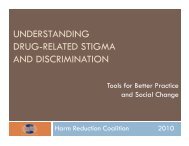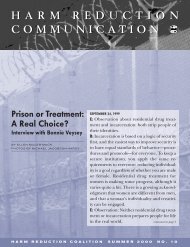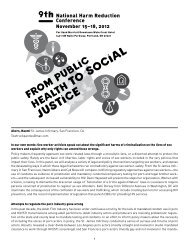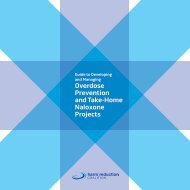PROMOTING SECONDARY EXCHANGE: - Harm Reduction Coalition
PROMOTING SECONDARY EXCHANGE: - Harm Reduction Coalition
PROMOTING SECONDARY EXCHANGE: - Harm Reduction Coalition
Create successful ePaper yourself
Turn your PDF publications into a flip-book with our unique Google optimized e-Paper software.
<strong>PROMOTING</strong> <strong>SECONDARY</strong> <strong>EXCHANGE</strong>:<br />
opportunities to advance public health<br />
Anna Benyo, MA<br />
Produced by The <strong>Harm</strong> <strong>Reduction</strong> <strong>Coalition</strong>, Syringe Access Expansion Project 2006<br />
with funds provided by the New York City Council,<br />
through the Injection Drug User Health Alliance.<br />
Edited by Jen Curry and Daniel Raymond
Executive Summary<br />
Secondary exchange is an important but<br />
underemphasized component of HIV and<br />
hepatitis C prevention for injection drug users<br />
(IDUs). Secondary exchange refers to a range<br />
of formal and informal practices through<br />
which syringe exchange participants<br />
redistribute sterile syringes to peers within<br />
social and drug-using networks. Despite their<br />
remarkable success in disease prevention,<br />
syringe exchange programs (SEPs) directly<br />
reach between 5-10% of active injection<br />
drug users. With changing communities,<br />
gentrification, and shifting drug trends, it is<br />
clear that public health policies must respond<br />
by promoting practices that reach the most<br />
at-risk communities. Secondary exchange<br />
therefore facilitates access to sterile syringes<br />
for a far greater number of drug users.<br />
Syringe exchange programs and policymakers<br />
should develop policies, programs,<br />
and strategies that aggressively encourage<br />
secondary exchange. Furthermore, secondary<br />
exchange can be harnessed to disseminate<br />
accurate risk reduction and disease prevention<br />
information, encourage health-promoting<br />
social norms and behavioral change, and recruit<br />
members of drug using social networks into<br />
higher-threshold services and interventions.<br />
This report includes a set of recommendations<br />
intended to facilitate, expand, and capitalize<br />
on secondary exchange.<br />
Recommendations<br />
• Revise local, state, and program policies<br />
to maximize the public health benefits of<br />
secondary exchange. Syringe exchange<br />
regulations and policies should shift away<br />
from the one-for-one exchange paradigm and<br />
strive to ensure that exchange participants<br />
obtain adequate numbers of syringes<br />
for themselves and their peer networks.<br />
Changing polices and procedures that require<br />
caps on the number of syringes received<br />
by participants and implementing explicit<br />
strategies and campaigns to encourage and<br />
support secondary exchange will increase<br />
the number of sterile syringes available to<br />
injectors and promote community health.<br />
• Develop new models that engage secondary<br />
exchangers to enable social network<br />
interventions including HIV, hepatitis C, and<br />
overdose prevention, as well as recruitment to<br />
higher-threshold services (i.e., HIV and STD<br />
testing, hepatitis A & B vaccination, etc.).<br />
• Design gender-specific approaches to engage<br />
female recipients of secondary exchange.<br />
Promote and support women peer educators<br />
trained on risk reduction for women IDUs.<br />
• Explore strategies to ‘incentivize’ secondary<br />
exchange, including efforts to a) recognize<br />
the work of secondary exchangers within<br />
programs, b) convene special meetings,<br />
events, or trainings for secondary exchangers,<br />
and c) compensate secondary exchangers for<br />
achieving specified outreach and/or education<br />
objectives within their networks.<br />
• Develop strategies to harness the role of<br />
secondary exchangers to increase the flow<br />
of information to programs. Secondary<br />
exchangers provide valuable information<br />
concerning drug trends, law enforcement<br />
practices, and overdose rates and response<br />
patterns. Programs should also devise simple<br />
measures and estimates of the extent and<br />
reach of secondary exchange conducted by<br />
participants, either as periodic surveys or ongoing<br />
data collection.<br />
“Syringe access<br />
programs are one of the<br />
most effective methods<br />
of disease prevention<br />
among injection drug<br />
users. Over a decade’s<br />
worth of scientific<br />
research concludes<br />
that syringe exchange<br />
programs play an<br />
essential role in<br />
reducing the spread of<br />
blood-borne illnesses<br />
such as HIV and<br />
Hepatitis B and C.”<br />
• Establish greater safe disposal options for<br />
secondary exchange providers and recipients;<br />
such options include distributing individual<br />
fit-packs, providing education on needlestick<br />
injuries, and establishing community safe<br />
disposal kiosks.<br />
• Policies should promote safe disposal and<br />
education among secondary exchangers but<br />
not require secondary exchangers to collect<br />
used syringes to return at SEPs. Polices must<br />
recognize that a) IDUs employ a range of valid<br />
and safe strategies to dispose of used syringes,<br />
and b) requiring secondary exchangers to<br />
return syringes used by others may increase<br />
their risk of infection through needlestick<br />
injuries.<br />
• Syringe exchange programs, local health<br />
clinics, and community based organizations<br />
should pilot low-threshold models that train<br />
secondary exchangers as peer educators.<br />
To be effective, these models should<br />
require the minimum amount of training<br />
and documentation necessary and provide<br />
substantial flexibility to programs and<br />
participants.<br />
Background<br />
Syringe access programs are one of the most<br />
effective methods of disease prevention<br />
among injection drug users. Over a decade’s<br />
worth of scientific research concludes that<br />
syringe exchange programs play an essential<br />
role in reducing the spread of blood-borne<br />
illnesses such as HIV and hepatitis B and<br />
C. 1 Research consistently demonstrates<br />
that syringe exchange programs and overthe-counter<br />
pharmacy sales of syringes are<br />
valuable public health interventions that<br />
target ‘hard to reach’ populations of injection<br />
drug users, providing a ‘bridge’ to medical,<br />
mental health, and addiction treatment. Yet,<br />
despite documented efficacy and the positive<br />
health benefits associated with participation<br />
in a syringe exchange program, their<br />
implementation is not widespread.<br />
Social, legal, and political constraints deter<br />
the development of syringe access programs,<br />
resulting in limited access to—and circulation<br />
of—sterile syringes in many communities.<br />
Recent research suggests that while the total<br />
number of syringes exchanged is on the rise,<br />
the number of syringe exchange programs<br />
has decreased slightly. 2 Logistical barriers<br />
and finite resources suggest that, even under<br />
the most optimistic scenarios, SEPs will<br />
never directly reach more than a fraction of<br />
IDUs. A practice known as ‘secondary and<br />
satellite exchange’ is a supplementary method<br />
to increase the number of sterile syringes in<br />
circulation and reach injection drug users who<br />
are unable or unwilling to attend a syringe<br />
exchange program. 3<br />
Secondary exchange is a broad term<br />
encompassing practices that range from<br />
semi-formal arrangements among a stable<br />
peer network which one member serves<br />
as ‘designated exchanger’ for the group to<br />
more informal patterns where exchangers<br />
provide, loan, or sell syringes to peers on<br />
an as needed basis. Strategies to promote<br />
secondary distribution and exchange offer a<br />
complementary approach to increase syringe<br />
access, disseminate health promotion and<br />
disease prevention messages, and engage more<br />
IDUs.<br />
Promoting Secondary Exchange: opportunities to advance public health
This report intends to:<br />
1. Explore the dynamics of secondary exchange<br />
2. Outline advantages and shortcomings<br />
associated with secondary exchange<br />
3. Propose recommendations to diversify<br />
models of syringe access in order to capitalize<br />
on the practice of secondary exchange<br />
Secondary Exchange:<br />
scope and practice<br />
Based on a recent nationwide survey of<br />
syringe exchange programs, 90% of programs<br />
encourage secondary exchange and the vast<br />
majority of IDUs supply syringes to others. 4<br />
In a California research study, approximately<br />
75% of SEP participants reported engaging in<br />
secondary exchange. Studies also document<br />
the extent to which secondary exchange<br />
increases the number of sterile syringes in<br />
circulation. A research study in Chicago found<br />
that 22% of the 40,000 syringe exchange<br />
visits involved secondary exchange; these<br />
transactions accounted for over half of all<br />
syringes exchanged at that program. 5 Most<br />
often, secondary exchange takes place through<br />
peer networks where an IDU participating in<br />
a syringe exchange program supplies sterile<br />
syringes (and often injection equipment such<br />
as cookers, cotton, and alcohol pads) to friends,<br />
family members, lovers, and/or associates. 6<br />
Research demonstrates that syringe<br />
exchange programs are successful in reaching<br />
predominantly male, long-time drug injectors;<br />
however, studies suggest that SEPs are less<br />
effective in reaching younger injectors, women,<br />
and new drug users. 7 When compared<br />
to primary SEP participants, recipients of<br />
secondary exchange are more likely to be<br />
younger and newer to injection drug use<br />
than their counterpart SEP participants. In<br />
addition, more women participate in secondary<br />
exchange, most often, with an IDU partner. 8<br />
These ‘hidden’ groups of IDUs are underrepresented<br />
at SEPs but often participate in<br />
secondary exchange and receive syringes<br />
through peer and partner networks.<br />
Motivations to participate in<br />
secondary exchange: providers and<br />
recipients<br />
IDUs engage in secondary exchange as<br />
‘provider’ and/or ‘recipient’ for different<br />
reasons. For providers, the primary motivation<br />
to supply sterile syringes is altruistic; qualitative<br />
research studies found that the driving force<br />
behind secondary exchange is a strong desire<br />
to help others. 9 IDUs who were recipients in<br />
secondary exchanges reported that convenience<br />
was the primary factor in receiving syringes<br />
through peer networks rather than through<br />
SEPs. Research suggests that IDUs are more<br />
likely to acquire syringes through secondary<br />
exchange when access to SEPs is limited. 10 The<br />
location of a SEP is significant because IDUs<br />
required to travel longer distances to access<br />
programs report fear of police harassment as<br />
a major factor in participating in secondary<br />
exchange.<br />
Reasons cited by injection drug users<br />
as disincentives for participation in a<br />
syringe exchange program include:<br />
- Fear of targeting by law enforcement<br />
- Privacy concerns (not wanting to be<br />
identified publicly as an IDU)<br />
- Inconvenient or inaccessible hours or<br />
location of SEPs<br />
- Employment schedule conflicts with hours of<br />
exchange<br />
“Strategies to promote<br />
secondary distribution<br />
and exchange offer<br />
a complementary<br />
approach to increase<br />
syringe access,<br />
disseminate health<br />
promotion and disease<br />
prevention messages,<br />
and engage more<br />
injection drug users.”<br />
- Lack of consistent transportation<br />
- Disability (including disease, injury, and<br />
mental illness)<br />
- Homelessness or transient housing (lack of<br />
safe place to store syringes)<br />
- Alternative access to syringes (through<br />
dealers)<br />
- Drug lifestyle (desire to limit use)<br />
- Legal status (probationer, parolee, fear of<br />
outstanding warrants)<br />
Secondary Exchange:<br />
advantages and disadvantages<br />
Research investigating the health benefits of<br />
secondary and satellite exchange found that<br />
both practices are valuable means of increasing<br />
sterile syringe circulation, especially among<br />
high-risk groups. Secondary exchangers<br />
engage the groups most at risk for drug-related<br />
harm including women, younger injectors<br />
and new IDUs—many of whom do not<br />
regularly participate in SEPs. While secondary<br />
exchange is effective in distributing sterile<br />
syringes to non-SEP users, research suggests<br />
that health promotion benefits and disease<br />
prevention messages are diminished during<br />
these encounters. Studies of injection-related<br />
risks among primary SEP users, secondary<br />
exchange recipients, and drug users not<br />
utilizing these services found mixed results.<br />
In some instances, individual risk behaviors<br />
were significantly higher among IDUs who did<br />
not attend a SEP or receive syringes through<br />
secondary exchange. 11 However, other<br />
research documented similar levels of risky<br />
injection behavior among secondary exchange<br />
recipients and non-secondary exchange IDUs.<br />
A qualitative study in California found that<br />
secondary exchange providers replicated myths<br />
about HIV transmission and did not deter users<br />
from sharing injection equipment or other<br />
high-risk practices.<br />
Women<br />
Studies consistently illustrate that women<br />
who inject drugs are much more likely engage<br />
in practices that place them at high risk for<br />
disease. Women are more likely to have an IDU<br />
sex partner and also more apt to trade sex for<br />
money or drugs. 12 Findings from a Baltimore<br />
study reported that women who engaged in<br />
secondary exchange were significantly more<br />
likely to become infected with HIV than<br />
their male IDU counterparts. 13 Researchers<br />
suggested that interconnected drug and<br />
sexual partnerships created a heightened risk<br />
environment.<br />
The role of peer networks:<br />
opportunities for intervention<br />
Secondary exchange is embedded in existing<br />
social networks and functions alongside peer<br />
education. 14 These networks can be informal<br />
arrangements, taking place during drug sales<br />
or use. According to a recent qualitative<br />
research study, secondary exchange also<br />
takes place formally, operating as a quasisyringe<br />
exchange program with established<br />
hours, clients, procedures, and educational<br />
information. Secondary exchange providers<br />
operate within peer networks that have limited<br />
or non-existent contact with SEPs. Therefore,<br />
these providers serve as advocates who share<br />
and disseminate risk reduction information<br />
as peer educators. Although participation in a<br />
syringe exchange program is associated with a<br />
reduction of syringe sharing, it does not result<br />
in cessation of all syringe sharing. Research<br />
from a study at a Baltimore syringe exchange<br />
continued >>
program showed that 78.3% of SEP<br />
participants reported sharing with a close<br />
friend. The study found that IDUs engage in<br />
selective risk taking – only sharing syringes<br />
with close friends or people with whom<br />
they had strong ties in their peer networks.<br />
Risk taking was not random; IDUs were<br />
less likely to share syringes with strangers<br />
or weaker-known associates. This was<br />
particularly true for women, who are more<br />
likely to share syringes with close friends or<br />
partners.<br />
Researchers noted that when networks<br />
are relatively closed, with low disease<br />
prevalence rates among the group, the IDU<br />
is ‘protected’ or insulated from outside<br />
exposure. However, researchers also<br />
found that there is significant turnover<br />
within close-friend networks; the role of<br />
‘close-friend’ changes over time. 15 For<br />
syringe exchange programs and secondary<br />
exchange models, these findings represent<br />
an opportunity to tailor disease prevention<br />
messages and provide targeted counseling<br />
on syringe sharing and risk behavior in the<br />
context of close friendships, partnerships,<br />
and peer networks.<br />
An innovative peer model recently<br />
established in Russia developed formal<br />
secondary exchange methods to counteract<br />
the overwhelming operational barriers<br />
(such as oppressive law enforcement tactics)<br />
to reach Russia’s largely ‘hidden’ IDU<br />
population. To offset these profound legal<br />
and law enforcement obstacles, advocates<br />
created an alternative SEP model that<br />
employed peer educators and actively<br />
recruited IDUs to promote secondary<br />
exchange. Since its inception, Project<br />
Renewal’s secondary exchange model is<br />
utilized more than the primary SEP program<br />
at both the fixed and mobile sites. 16<br />
Promoting secondary<br />
exchange: policy and public<br />
health goals<br />
Research demonstrates that the most<br />
effective disease prevention occurs when<br />
IDUs receive both sterile syringes and risk<br />
reduction messages during SEP transactions<br />
and encounters with staff. IDUs who visit<br />
SEPs consistently, exchange syringes for<br />
personal use, have access to ancillary social<br />
services and sustained engagement with<br />
harm reduction staff, have the lowest<br />
likelihood of HIV transmission, because they<br />
receive both sterile syringes and messages<br />
which influence individual behavioral<br />
change. Against the backdrop of limited<br />
resources and structural barriers to expand<br />
syringe access—as well as overall changing<br />
drug use trends—secondary exchange can<br />
enhance public health by increasing sterile<br />
syringe circulation in the IDU community. 17<br />
By using more formal peer education with<br />
SEP participants who perform secondary<br />
exchange, SEPs can capitalize on access<br />
to non-SEP-using IDUs and enhance<br />
their capacity to promote risk reduction<br />
strategies.<br />
1. Wodak, A, Cooney A. (2005) Effectiveness of sterile needle and syringe programs. International Journal of Drug Policy 16 (Supplement): S31:S44.<br />
2. Centers for Disease Control and Prevention http://www.cdc.gov/mmwr/preview/mmwrhtml/mm5427a1.htm<br />
3. Secondary exchange refers to the practice whereby a participant at a syringe exchange program receives more syringes than needed for their personal use and<br />
re-distributes sterile syringes among their peer networks and associates. Whereas satellite exchange refers to the practice of distributing large quantities of sterile<br />
syringes (through shipping or delivering) to locations that do not have syringe exchange programs (or very limited SEPs). The most notable difference in these<br />
practices is that secondary exchange often occurs among known associates and peers, and satellite exchange happens outside a personal network in a given<br />
community when syringes are distributed at a distance from the original exchanger. Both practices are quasi-legal based on state or local policies.<br />
4. Des Jarlais DC, McKnight C, Eigo K, Friedmann, P. (2000). Unites States Syringe Exchange Program Survey. North American Syringe Exchange Convention.<br />
5. Huo et al. (2005). Drug Use and HIV Risk Practices of Secondary and Primary Needle Exchange Users. AIDS Education and Prevention. Vol. 17(2).<br />
6. Snead, J., Moher, D., Lorvick, J., Garcia, B., Thawley, R., Kegeles, S., Edlin, B., (2003). Secondary Syringe Exchange Among Injection Drug Users. Journal of<br />
Urban Health Vol. 80 (2).<br />
7. Murphy et al. (2004). The Health Benefits of Secondary Syringe Exchange. The Journal of Drug Issues. Vol. 34.<br />
8. Booth, RE. (1995). Gender Differences in High-risk Sex Behaviors Among Heterosexual Drug Injectors and Crack Smokers. American Journal of Alcohol Abuse<br />
Vol. 21.<br />
9. Snead, J., Moher, D., Lorvick, J., Garcia, B., Thawley, R., Kegeles, S., Edlin, B., (2003). Secondary Syringe Exchange Among Injection Drug Users. Journal of<br />
Urban Health Vol. 80 (2).<br />
10. Lenton et al. (2006). Threat or Opportunity? Secondary Exchange in a Setting With Widespread Availability of Needles Substance Use & Misuse, 41:845-846.<br />
11. Murphy, S., Kelley, M., Lune, H. (2004). The Health Benefits of Secondary Syringe Exchange. Journal of Drug Issues. Vol. 34 (2)<br />
12. Riehman, K., Alex, K., Anderson, R., Flynn, N., Bluthenthal, R., (2004). Sexual Relationships, Secondary Exchange, and Gender Differences in HIV Risk<br />
Among Drug Injectors. Journal of Urban Health, Vol. 81 (2).<br />
13. Valente et al. (2001) Needle Exchange Participation, Effectiveness, and Policy: Syringe Relay, Gender, and the Paradox of Public Health. Journal of Urban<br />
Health. Vol. 78 (2).<br />
14. Snead et al. (2003). Secondary Syringe Exchange Among Injection Drug Users Journal of Urban Health: Bulletin of the New York Academy of Medicine.<br />
15. Valente, TW, Vlahov, D (2001). Selective Risk Taking Among Needle Exchange Participants: Implications for Supplemental Interventions. American Journal of<br />
Public Health. Vol. 91 No. 3.<br />
16. Irwin, K., et al (2006). Secondary Syringe Exchange as a Model for HIV Prevention in the Russian Federation. Substance Use & Misuse Vol. 41<br />
17. Valente et al. (2001) Needle Exchange Participation, Effectiveness, and Policy: Syringe Relay, Gender, and the Paradox of Public Health. Journal of Urban<br />
health: Bulletin of the New York Academy of Medicine.<br />
<strong>Harm</strong> <strong>Reduction</strong> <strong>Coalition</strong><br />
22 West 27th Street, 5th Floor<br />
New York, NY 10001<br />
Tel: (212) 213-6376 Fax: (212) 213-6582<br />
www.harmreduction.org<br />
e-mail: hrc@harmreduction.org











